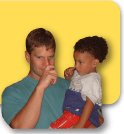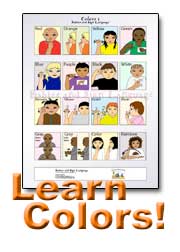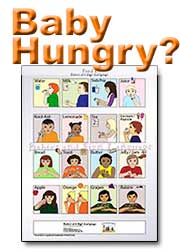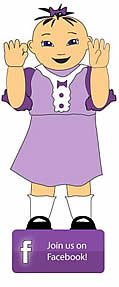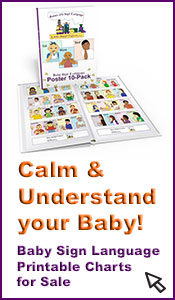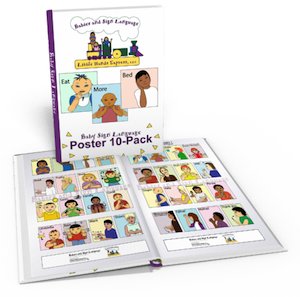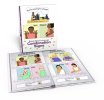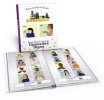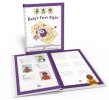Attachment Parenting, Hot Topics, and Sign Language

Any of these terms sound familiar?
These are hot topics in parenting circles these days and for good reason.
Parents today are looking for ways to give their babies the best natural benefits that they can.
These parents specifically are looking for the best natural foods, the best diapers, the best positive ways to discipline, and ways to promote intellectual development.
Attachment parenting is full of techniques that achieve wellness, balance, and positive development and baby sign language is on the definite rise for similar reasons. Both are full of benefits for babies and parents alike!
So First, What Exactly Is Attachment Parenting?
Attachment parenting is a natural-focused method of child-rearing that encompasses consistency, sensitivity, balance, and bonding.
This type of 'natural parenting' is about creating a strong relationship between parent and child. There are NO newly evolved concepts in attachment parenting. In fact, attachment parenting dates back to our early ancestors!
Think back to the storybooks you read in your childhood. Remember the pictures of the Native American mothers? They swaddled their babies and wore them on their back.
These babies learned to see the world from their mother's point of view. They were in tune with their mother's daily schedule. Babies who were 'worn' developed an attachment to their mother that set the foundation for a lifetime of learning!
Baby wearing remains to this day. And as you can see, the principles behind attachment parenting are basic, simple, and instinctive.
Typical Hot Topics in Attachment Parenting
-
Cloth diapers or disposables?
In a society that is becoming increasingly more aware of the environment, this may seem like an easy choice.
Many studies argue that disposable diapers are made of plastics that take hundreds of years to biodegrade. Others researchers suggest that diapers alone make up over 75 million tons of waste in our landfills!
Cloth diapers may save our landfills, but they require multiple washings which depletes water and energy. :-(

These facts are breathtaking, and yet environmental protection is not the most impressive argument.
What is even more impressive is the fact that infants can be potty trained. Not toddlers, not young children, but infants. It is not natural for babies to sit in their own waste, nor is it time efficient for most parents to change diapers ten times a day. Instead, elimination communication can be used to potty train infants from early on.
-
Elimination Communication and Infant Potty Training
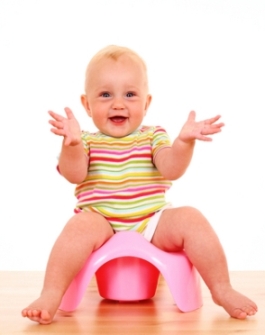
Elimination communication is the idea that parents can eliminate the need for diapers by tuning in to their child's need to eliminate waste.
This can be done by scheduling time for elimination to occur or by paying attention to non-verbal cues, such as discomfort.
Many parents will pair this method with a verbal cue, such as "psssssss" to indicate that it is time to urinate, or making a raspberry sound to indicate that it is time for a bowel movement.
The drawbacks to this method are that newborns and very young infants need to urinate very often, especially during sleep.
During this potty training period, cloth diapers are a wonderful, environmentally friendly supplement.
-
Breastfeeding / Nursing Naturally
Breastfeeding has many benefits over formula-based bottle feeding. Breast milk is the most nutritious form of milk because it is perfectly balanced with nutrients, unlike formula.
This balance often results in easier digestion for the baby as well. Studies have linked breastfeeding to higher IQ, but there may be other factors involved such as differences in parenting between mothers that choose to breastfeed and mothers that choose to formula-feed.
Many mothers are choosing to breastfeed, knowing that they are providing these benefits to their growing baby. This nurturing relationship creates a strong bond with a new baby and fathers can also play a big part in this.
Now you're really wondering?! How can fathers benefit from breastfeeding? Fathers can play a big part by tuning in to their baby's needs and delivering the baby to the mother to be fed.
Babies will develop the same trusting bond with their fathers because they will association transportation to feeding with Daddy. Breastfeeding is really a team effort and is highly beneficial for families.
|
Check out "Fathers Who Benefit With the Use of Sign Language With Their Babies" |
-
Natural and Organic Baby Foods

In this country (USA), many babies start out on processed foods that lack the same amount of nutrients as fresh produce.
Attachment parenting is all about wellness and balance and natural food plays a big role in that. There are many organic baby foods now that are flash-frozen, keeping the nutrients intact.
Another more time-consuming alternative is to buy a food processor and to create your own delicious and nutritious baby food.
This can not only save on cost, but also save on wasted plastic disposable containers and glass baby food jars.
What a wonderful way to put a few dimes in the bank and delight in watching your child develop in the healthiest way possible!
-
Co-sleeping / Family Beds
There are a number of advantages to co-sleeping, or using a family bed. One reason that many parents prefer co-sleeping is that it is easier to breastfeed in the middle of the night.
Co-sleeping saves many trips to the nursery and many parents are able to get better, more restful sleep this way.
Co-sleeping also strengthens the trust bond with a baby. Babies feel safer and more comforted in a co-sleeping arrangement.
Oftentimes, as babies grow older, parents will gradually move them into a separate room and leave co-sleeping as a comforting option that is always there.
This way, children are able to explore independence knowing that their comfortable "safety blanket" will always be there for them.
-
Babywearing and Slings
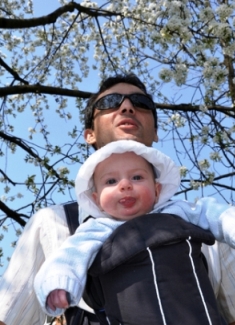 |
Maybe you have seen moms and/or dads around town with their infants in shoulder slings.
Slings are growing in popularity as more parents are learning about attachment parenting.
The idea behind baby-wearing is that babies are up high, viewing the world from your perspective.
It is a big world out there from an infant's perspective, and that world becomes limited when a baby is crawling on the ground.
In a sling, babies have access to a much greater world. They become part of everyday conversations. They have better visual access to facial expressions and language.
These babies are much more in-tune with their parent's daily schedule. Slings also provide support for the parent doing the carrying. It can be exhausting to constantly pick up and put down a child.
Slings also provide better back support and are hands-free, allowing parents to get more things accomplished during the day without feeling so fatigued at the end! With all of these benefits it is no wonder that baby-wearing has become so popular!
-
Positive Discipline and Reinforcement
Positive discipline really begins at birth. Through many of the attachment parenting techniques such as breastfeeding and co-sleeping, an infant develops attachment and trust.
These techniques form the bases for positive discipline because they incorporate consistency and compassion.
Positive discipline doesn't wait for a child to misbehave; it aims to prevent the misbehavior from occurring (or reoccuring). Of course kids will always be kids, but oftentimes babies communicate their needs and want through their behavior.
Positive discipline is about knowing your baby and meeting your baby's needs to prevent them from being communicated in a negative way.
It's about creating an emotionally safe environment in which your infant can experience natural consequences. It emphasizes affirmation.
For example: You and your child go to the park. He says, "Swing!" and you reply, "Yes, you may swing. Be careful, there are rocks here. You may walk to the swing."
Your child begins to run in excitement and falls down, scraping his knee. You reassure him that he is okay and pick him up to comfort him.
This is a great example of instructing in an affirming way by letting the child know what he MAY do instead of what he MAY NOT do. It is also an example of allowing the child to experience natural consequences while providing a supportive and reassuring environment.
Positive discipline is not an easy thing for many parents. It requires research and commitment, but in the end it can be a wonderful way to provide discipline to children while promoting positive emotional development.
-
Baby Sign Language
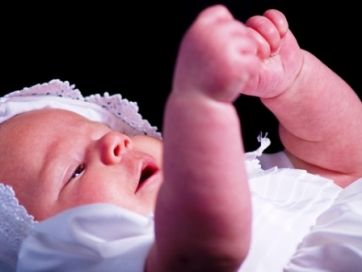
What's all the hype about? Perhaps one of the hottest topics in attachment parenting and other parenting circles is baby sign language.
Baby sign language (as you can see from this website) is all about promoting language development and communication before an infant is physically able to speak.
Baby sign language fits beautifully into the attachment parenting lifestyle because it is a natural way for an infant to bond with his or her mother and father.
All in all, parenting is about doing what is best for you and your baby. Attachment parenting seeks to strengthen the bond of attachment and trust and provide a compassionate environment for your baby to grow in.
Neither parenting nor childhood should be stressful. Attachment parenting and baby sign language are great ways to make parenting and childhood a positive and memorable experience.
See more on "Attachment Parenting and Utilizing Sign Language With Babies and Toddlers" - Click Here
Related Positive Learning With Sign Language Topics:

